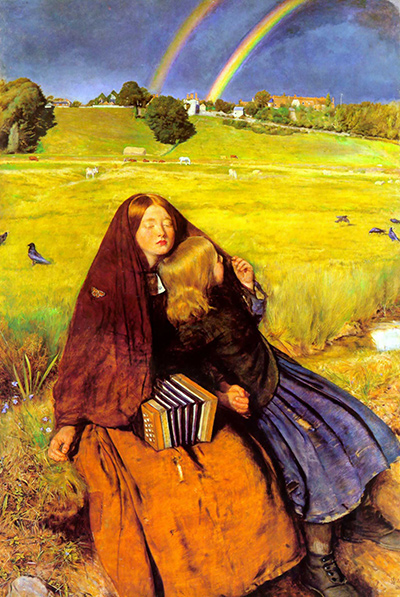The blind girl is a painting by john Everett Millais (1956). It portrays two beggar girls sitting by the roadside after a storm.
Millais shows the two girls dressed in dull worn out clothes which contrast with the bright background of open fields with cattle and birds and a town, in a distance.
The elder of the two girls is blind. She appears to be responsible for the younger girl, who could be her sister. She is holding her hands while partially sitting on her lap and leaning on her chest. They might be on their way to the town to earn a few pennies by entertaining the people in the town using the accordion on the older girl’s lap.
Showing the different experiences of the two girls, the painting has been portrayed as an allegory of the senses. Apart from sight, the blind girl has all her senses enhanced. She can feel the touch of the younger girl in her left hand. She examines the feel of the grass in her right hand.
Her head is tilted, which gives her the opportunity to fully appreciate the warmth of the sun on her face, take in the smell of the country around her and enjoy the sounds of the birds and mooing cows. The blind girl is enjoying the environment around her. She is sitting so still that a tortoiseshell butterfly rests on her shawl, probably mistaking her for a flower.
Her companion, on the other hand, is snuggling so closely within the shawl of the blind girl and holding her hand. Perhaps scared of the storm that just passed and being comforted by the blind girl. Or just shielding her eyes from the sun and looking at the amazing beauty of the double rainbow. Some critics have suggested that the rainbow is a reminder of God’s covenant with Noah after the floods in the Bible.
It is interesting to note that Millais had originally painted the colours of the two rainbows in the same order. He later altered the painting and had the inner rainbow inverted for scientifical accuracy.
The background view is the town of Winchelsea. It is a known fact that Millais visited this town in 1952 and finished the middle ground of the painting in Perth. Scotland in the summer of 1955. History of the painting has it that the amber-colored skirt worn by the blind girl was the last thing to be painted.
The blind girl received the annual Liverpool Academy award in 1857 and is now viewed as Millais’ best works of art.




